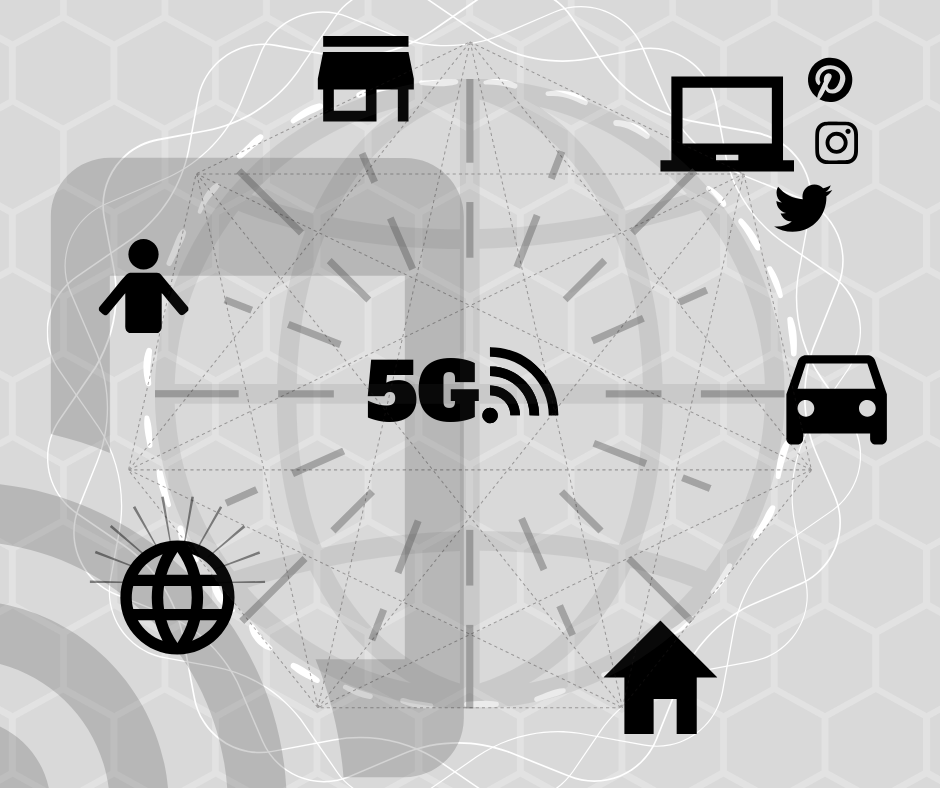5G Network Rollout Expected to Stir Things Up
Three point three billions. This is the amount of smartphone users around the world for the year 2019 (Statistica). For the following two years, the expected amount of users is to reach 3.5 and 3.8 billions (Statistica). Among what makes a smartphone “smart” is its ability to send and receive emails, edit documents, download applications, etc. All of these actions are enabled because our smartphones -as well as other smart devices for that matter- are connected to the Internet (Cassavoy).

However, for a smartphone to access the Internet and give its user the ability to surf the web, or enjoy its cool features, it has to be connected to either a Wi-Fi network or a cellular network technology, such as 3G or 4G. Yet, a new generation of cellular network technology will be succeeding the current technology (Holst). It is 5G or fifth generation.

In the United States of America, all four wireless carriers have already started to work on this new system, and 5G-capable phones are already on the market (McGarry). The first standards-based deployments started in 2018, and will accelerate in 2019 and the years 2020s (Rysavy Research 21).
This represents an important change, not only for smartphone users but for companies, developers and any person who is interested in using online platforms or artifacts that require an internet connection. Indeed, according to Rysavy Research, a consulting firm specializing in technology including the wireless industry, applications for 5G will have a “huge economic and societal impact” (25). Among the expected utilizations that will leverage 5G capability, we will find: augmented reality and virtual reality, ultra-high definition video, healthcare, fixed wireless access, cloud gaming, video surveillance, automotive, smart cities, education, monitoring of infrastructure, wearable computing, manufacturing and other industrial applications (26).
What is the difference between 5G and other similar technologies?
It all started with 1G, which refers to analog cellular technologies and became available during the 1980s (Rysavy Research 20). In the 1990s, 2G, representing the first generation of digital cellular technologies came out, enabling services such as “short messaging and lower-speed data” (20). Then, 3G technologies arrived, with them the possibility to access the internet on smartphones (20). In 2008, the International Telecommunications Union (ITU) fixed specific requirements as for what the 4G technologies needed to fulfill. The goal was to improve “data coverage, capacity and quality of experience” (20). 4G facilitated video streaming and allowed the development of an “economy of apps” (McGarry). At the time, 4G was associated with HSPA+ (Evolved High Speed Packet Access) and WiMAX (Wireless Interoperability for Microwave Access), but nowadays, it mostly refers to LTE (Long Term Evolution) and HSPA+ (Rysavy Research 20).
Now for 5G, while the ITU fixed technical objectives, the 3rd Generation Partnership Group (3GPP) is developing specifications for the new standard (21). Those specifications include a downlink peak rate of 20Gbps and an uplink peak rate of 10Gbps, which can be compared with the respective objectives for 4G of 1Gbps and 0.5Gbps (23). With 5G and the new Ultra-Reliable and Low-Latency Communications (URLLC), the user plane latency should go down to 1 msec, in comparison to 4G’s 10 msec (24). That means that the network will be more responsive (Segan). Another requirement includes a higher spectral efficiency -“the channels ability to carry information given fixed bandwidth” (Cheng, Keintola)- with a peak rate of DL: 30 bps/Hz and UL: 15 bps/Hz (Rysavy Research 23). These values are twice as big as the ones for the 4G standard, which respectively reach 15 bps/Hz and 6.75 bps/Hz (23).
With its new and higher requirements fixed by the ITU, it is said that 5G will be able to support ten times as many devices in an area as LTE (Rysavy Research 15). This makes a big difference as far as the Internet of Things and smart devices are concerned, making it easier for the potential development of smart cities. Also, the URLLC will enable “industrial automation, drone control, new medical applications, and autonomous vehicles” (12).
It is important to note that the 5G network rollout does not come without controversy.
First of all, just like it has been the case when many other “new” technologies came out, such as Blu-ray Disc, Secure Digital cards, or even wireless chargers, this time again, there is a need for new equipment that can read and work with 5G networks. Indeed, our personal smartphones are likely not to receive the 5G signal and in order for us to enjoy the great advantages of 5G, we will have to invest in new high-priced devices (McGarry).

Secondly, another potential issue deals with the negative effects 5G might have on our society. We are aware that the internet as well as other new technologies have many downsides and have participated in the creation of an “attention economy,” in which there is plenty of information, but a scarcity of attention (Crogan, Kinsley 3). Because attention is a new type of currency for companies, many of the devices and online platforms we use on a daily basis are designed to be addictive (e.g. infinite scroll on Facebook and Instagram) (Gentry). This “tech addiction” comes from the release of dopamine in our brain that happens whenever we check our devices and that creates a “false sense of accomplishment” (Brandon). This attention economy has had quite an impact on our daily lives in terms of time, mental health and social behaviors (Gentry) and we can thus wonder if this phenomenon will be exacerbated with the 5G’s ultrafast and improved connectivity.
Lastly, many people are concerned about the safety of the new technology. 5G uses high frequency millimeter radio signals, called “millimeter waves” (Tabora). Those waves cannot properly cross walls nor can they travel very long distances. Because of that, for the good functioning of 5G, many small cell towers will have to be installed within a distance of no less than 200 feet and no more than 1,000 feet apart (Tabora). This situation raises health-related concerns and people are fearing this future radiation exposure (Tabora).
“5G is already here, but unless the stars of your location, the wireless carrier you subscribe to and the smartphone you own are perfectly aligned, you probably can’t use it yet.”
Caitlin McGarry (tomsguide.com)
As we have seen, people will have to stay put and wait a bit longer before being able to enjoy 5G in its full capacity. Meanwhile, people can start to acquire the right equipment so that once the new technology is available everywhere and fully working, they will be able to take advantage of its great capabilities. The new technology is indeed expected to make waves and stir things up. So be ready.
Bibliography:
- Brandon, John. ‘The Surprising Reason Millennials Check Their Phones 150 Times a Day’. Inc.Com, 17 Apr. 2017, https://www.inc.com/john-brandon/science-says-this-is-the-reason-millennials-check-their-phones-150-times-per-day.html.
- Cassavoy, Liane. ‘What Makes a Smartphone Smarter Than a Cell Phone?’ Lifewire, 24 June 2019, https://www.lifewire.com/what-makes-a-smartphone-smart-579597.
- Cheng, Thomas, and Antti Keintola. ‘Why Does Spectral Efficiency Matter?’ Blue Danube, 23 July 2018, https://www.bluedanube.com/blog/2018/07/23/why-does-spectral-efficiency-matter/.
- Crogan, Patrick, and Samuel Kinsley. ‘Paying Attention: Towards a Critique of the Attention Economy’. Culture Machine, vol. 13, 2012, pp. 1–29.
- Donadini, Romane. 5G. Sept. 2019.
- Gentry, Ashley. ‘The Attention Economy Is Breeding Addiction, Fraud, and Hate — and This Is What We Need to Do to Save It’. Business Insider, https://www.businessinsider.com/broken-attention-economy-op-ed-2019-3. Accessed 20 Sept. 2019.
- ‘Global 5G: Implications of a Transformational Technology’. Rysavy Research/, Sept. 2019, pp. 1–254.
- Holst, Arne. ‘5G – Statistics & Facts’. Statista, 29 Mar. 2019, https://www.statista.com/topics/3447/5g/.
- McGarry, Caitlin. ‘What Is 5G? The Definitive Guide to the 5G Network Rollout’. Tom’s Guide, Aug. 2019, https://www.tomsguide.com/us/5g-release-date,review-5063.html.
- ‘Number of Smartphone Users Worldwide 2014-2020’. Statista, https://www.statista.com/statistics/330695/number-of-smartphone-users-worldwide/. Accessed 20 Sept. 2019.
- Rawpixel Ltd. Group of Diverse People Using Smartphones. 28 Mar. 2018. Flickr, https://www.flickr.com/photos/byrawpixel/45739287092/.
- Segan, Sascha. ‘What Is 5G?’ PCMag, 28 Aug. 2019, https://www.pcmag.com/article/345387/what-is-5g.
- Tabora, Vince. ‘5G Networks Can Change The Way We Live: For Better or Worse?’ Hackernoon, 21 Dec. 2018, https://hackernoon.com/5g-networks-can-change-the-way-we-live-for-better-or-worse-ed2b3fc6b0e6.
- What Is 5G? — Clarification Please. Mashable, 2019, https://mashable.com/video/what-is-5g-clarification-please/?europe=true&utm_cid=a-bonusvideo.



